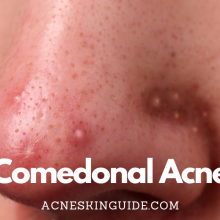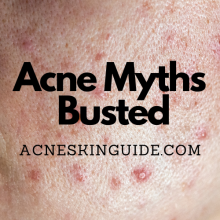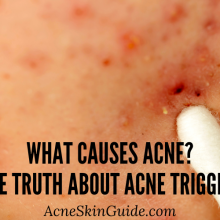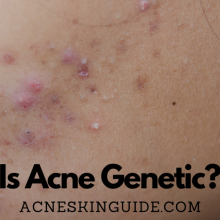What Are Blackheads – Complete Answer | AcneSkinGuide
Summary of Answering What Are Blackheads
Blackheads, also known as open comedones, are dark spots on the skin caused by clogged hair follicles with oil, dead skin cells, and bacteria. Their formation involves excess sebum production triggered by hormones, dead cell buildup, and acne-causing bacteria. Preventing blackheads requires a consistent skincare routine with gentle cleansing, exfoliation, and non-comedogenic products.
Treatment options range from home remedies like clay masks to over-the-counter products with salicylic acid, to professional procedures like extractions and chemical peels for severe cases. Proper extraction techniques are crucial to avoid irritation, scarring, and infection. While generally harmless, blackheads can lead to inflammatory acne lesions if untreated. Separating facts from myths like the “dirt causes blackheads” misconception is key to effective blackhead management for clear, healthy skin.
Our Top 3 Recommended Acne Treatment Products

#1 Paula's Choice Acne Treatment
The 3-step kit features a cleanser and exfoliating solution with 2% salicylic acid, as well as a 5% benzoyl peroxide treatment that effectively treats even severe acne, though the benzoyl peroxide can be drying. The kit delivers serious results for stubborn acne, despite its slightly higher price point compared to drugstore options. Check The Price Now
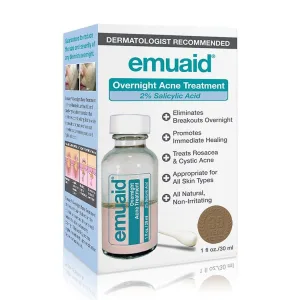
#2 EMUAID Overnight Acne Treatment
The EMUAID Overnight Acne Treatment features a two-phase solution, with an exfoliating first step to unclog pores and an intensive treatment gel that rapidly reduces inflammation, redness, and swelling of even severe, cystic breakouts, despite a slightly medicinal scent and higher price point compared to other options. Check The Price Now

#3 Differin Acne Treatment
The Differin 0.1% adapalene gel normalizes cell turnover and unclogs pores to effectively treat acne, though it requires 2-3 months of consistent use with an adjustment period of dryness and purging before seeing maximum results, which are worth the effort for clearer, more even-toned skin. Check The Price Now

Understanding Blackheads: A Comprehensive Guide
Blackheads, those pesky dark spots that dot our skin, are a common concern for many individuals. While they may seem like a minor annoyance, understanding what blackheads are and how to properly manage them is crucial for maintaining clear, healthy skin. In this comprehensive guide, we’ll delve into the world of blackheads, exploring their formation, causes, treatment options, and potential downsides.
What Are Blackheads?
Blackheads, scientifically known as open comedones, are a type of acne lesion that appears as small, dark spots on the skin’s surface. They form when excess oil (sebum), dead skin cells, and bacteria become trapped in the hair follicles, creating a plug that remains exposed to air. This exposure causes the plug to oxidize and turn black, giving blackheads their characteristic appearance.
Formation and Causes
The formation of blackheads is a complex process that involves several factors. One of the primary causes is an overproduction of sebum, which can be triggered by hormonal changes during puberty, menstrual cycles, pregnancy, or certain medical conditions. Additionally, the buildup of dead skin cells and the presence of acne-causing bacteria, such as Propionibacterium acnes, contribute to the clogging of pores.
Blackheads typically appear on areas with a high concentration of sebaceous glands, such as the face, nose, chin, and forehead. However, they can also occur on other body parts, including the back, chest, and shoulders.
Prevention and Skincare Routine
Maintaining a consistent and effective skincare routine is crucial for preventing blackheads and managing their appearance. Here are some key steps to consider:
- Cleanse regularly: Use a gentle, non-comedogenic (non-pore-clogging) cleanser to remove excess oil, dirt, and impurities from the skin’s surface.
- Exfoliate: Regular exfoliation helps slough off dead skin cells, preventing them from accumulating and clogging pores.
- Use targeted products: Look for skincare products containing ingredients like salicylic acid, retinoids, and alpha-hydroxy acids, which can help unclog pores and prevent blackhead formation.
- Avoid pore-clogging products: Steer clear of heavy, comedogenic products that can contribute to clogged pores and blackhead formation.
- Manage lifestyle factors: Factors like diet, stress, and environmental pollution can influence blackhead formation, so it’s essential to adopt a balanced lifestyle.
Treatment Options
If blackheads are already present, there are several treatment options available, ranging from home remedies to professional treatments. Here are some common approaches:
- Home remedies and natural treatments: Clay masks, tea tree oil, and other natural ingredients can help absorb excess oil and gently remove blackheads.
- Over-the-counter treatments: Pore strips, scrubs, and face masks containing ingredients like salicylic acid or benzoyl peroxide can help remove blackheads and unclog pores.
- Professional treatments: For more severe or persistent cases, professional treatments like extractions, chemical peels, or microdermabrasion may be recommended by a dermatologist or esthetician.
- Prescription treatments: In some cases, prescription topical treatments like retinoids or antibiotics may be necessary to address blackheads and accompanying acne.
Blackhead Removal and Extraction
While it may be tempting to squeeze or pick at blackheads, this can lead to further irritation, inflammation, and potential scarring. Instead, it’s essential to follow proper extraction techniques. This typically involves steaming the face to open pores, using specialized comedone extractors, and gently applying pressure to remove the plug. It’s important to note that improper extraction methods can cause long-term damage, so seeking professional assistance from a licensed esthetician or dermatologist is recommended.
Blackheads and Acne
Blackheads are often associated with acne, as they are a type of comedonal acne lesion. While blackheads themselves are not inflammatory, they can progress into inflammatory acne lesions like papules and pustules if not properly treated. Addressing blackheads early on can help prevent further acne breakouts and minimize the risk of scarring or hyperpigmentation.
Potential Downsides and Risks
While blackheads are generally not harmful, there are certain downsides and risks to be aware of:
- Scarring: Aggressive or improper extraction techniques can lead to scarring, especially if the skin is inflamed or irritated.
- Infection: Picking or squeezing blackheads can introduce bacteria into the skin, potentially leading to infections.
- Hyperpigmentation: Inflammation caused by blackheads or improper extraction can result in post-inflammatory hyperpigmentation, especially in individuals with darker skin tones.
- Skin irritation: Some treatment products or procedures may cause temporary skin irritation, redness, or dryness.
- Persistence: In some cases, blackheads can be persistent and difficult to treat, requiring ongoing management and professional assistance.
Separating Fact from Fiction
It’s important to separate fact from fiction when it comes to understanding and treating blackheads. One common misconception is that blackheads are caused by dirt or poor hygiene. However, this is not the case; blackheads are primarily caused by clogged hair follicles and excess oil production, not external factors like dirt.
Conclusion
Blackheads are a common skin concern that can be effectively managed with the right approach. By understanding their formation, causes, and appropriate treatment methods, individuals can take proactive steps to prevent and address blackheads. However, it’s crucial to exercise caution and seek professional guidance when necessary, as improper techniques or aggressive treatments can lead to potential downsides like scarring or infection. By adopting a consistent skincare routine, seeking professional assistance when needed, and separating fact from fiction, individuals can effectively manage blackheads and maintain clear, healthy skin.
FAQs and Answers
Can blackheads be permanent, or do they eventually go away on their own?
Blackheads are not typically permanent, but they can be persistent if not properly treated and managed. In many cases, blackheads will eventually clear up on their own, but this process can take several weeks or months.
The lifespan of a blackhead depends on various factors, such as the individual’s skin type, hormonal changes, and skincare routine. If the underlying causes of blackhead formation (e.g., excess oil production, clogged pores) are not addressed, new blackheads may continue to develop, leading to a cycle of blackhead formation and clearance.
Generally, blackheads that are left untreated may eventually shed naturally as the skin renews itself, and the plug of oil and dead skin cells is expelled from the pore. However, this process can be slow, and the blackhead may persist for an extended period before clearing up.
It’s important to note that while blackheads may eventually go away on their own, they can also progress into more severe acne lesions, such as inflammatory papules or pustules, if not properly managed. Consistent skincare routine, including regular exfoliation and the use of targeted products, can help remove blackheads and prevent new ones from forming.
In some cases, especially with severe or persistent blackheads, professional treatment from a dermatologist may be necessary to effectively remove them and address the underlying causes. Seeking professional help can prevent scarring, hyperpigmentation, and the potential worsening of acne.
Are there any specific dietary changes that can help prevent or reduce blackheads?
Yes, certain dietary changes can potentially help prevent or reduce the occurrence of blackheads. Here are some dietary recommendations that may be beneficial:
- Increase intake of foods rich in antioxidants: Antioxidants like vitamin C, vitamin E, and zinc can help reduce inflammation and oxidative stress, which can contribute to acne and blackhead formation. Foods rich in these antioxidants include citrus fruits, berries, nuts, seeds, and leafy green vegetables.
- Consume more omega-3 fatty acids: Omega-3 fatty acids, found in foods like fatty fish (salmon, mackerel, sardines), walnuts, and flaxseeds, have anti-inflammatory properties that may help reduce the inflammation associated with acne and blackheads.
- Limit intake of high-glycemic foods: Consuming too many high-glycemic foods, such as refined carbohydrates, sugary snacks, and beverages, can spike insulin levels and trigger hormonal fluctuations, potentially leading to increased oil production and blackhead formation.
- Stay hydrated: Drinking plenty of water can help flush out toxins and keep the skin hydrated, which may aid in preventing clogged pores and blackhead formation.
- Incorporate probiotics: Probiotics, found in fermented foods like yogurt, kefir, and sauerkraut, can help maintain a healthy gut microbiome, which may have a positive impact on skin health and acne prevention.
It’s important to note that dietary changes alone may not completely eliminate blackheads, but they can be an effective complementary approach when combined with a consistent skincare routine and other recommended treatments. Additionally, individual responses to dietary changes may vary, so it’s always best to consult a dermatologist or healthcare professional for personalized advice.
Can blackheads be a sign of an underlying medical condition or deficiency?
Yes, in some cases, persistent or severe blackheads can be a sign of an underlying medical condition or deficiency. While blackheads are a common and generally harmless form of acne, their presence can sometimes indicate an imbalance or issue that requires further investigation. Here are some potential underlying conditions or deficiencies that may contribute to or exacerbate blackheads:
- Hormonal imbalances: Hormonal fluctuations, such as those caused by polycystic ovary syndrome (PCOS), thyroid disorders, or hormonal contraceptives, can lead to increased sebum production and clogged pores, resulting in blackheads and other forms of acne.
- Nutritional deficiencies: Deficiencies in certain nutrients, such as zinc, vitamin A, and vitamin D, can affect skin health and potentially contribute to the development of blackheads and acne.
- Endocrine disorders: Conditions like insulin resistance, diabetes, or disorders affecting the adrenal glands can disrupt hormone levels and influence sebum production, leading to clogged pores and blackheads.
- Genetic disorders: Rare genetic disorders like Apert syndrome or Crouzon syndrome, which involve abnormalities in the development of facial bones and skin, can sometimes result in an increased risk of blackheads and acne.
- Medication side effects: Certain medications, such as corticosteroids, anabolic steroids, or lithium, can have side effects that include increased oil production and the formation of blackheads or acne.
If blackheads are persistent, severe, or accompanied by other concerning symptoms, it’s advisable to consult a dermatologist or healthcare professional. They can evaluate the situation, order relevant tests if necessary, and determine if there is an underlying medical condition or deficiency contributing to the blackhead formation. Addressing any underlying issues can help manage blackheads more effectively and promote overall skin health.
Is it safe to use pore strips or nose strips regularly for blackhead removal?
Using pore strips or nose strips regularly for blackhead removal is generally considered safe when done correctly and in moderation. However, there are some potential downsides and risks to be aware of:
Pros:
- Convenience: Pore strips are relatively easy to use and can be purchased over-the-counter, making them a convenient option for blackhead removal at home.
- Effectiveness: When used properly, pore strips can effectively remove some blackheads by adhering to and pulling out the clogged material from the pores.
Cons and Risks:
- Skin irritation: The adhesive used in pore strips can cause skin irritation, redness, and discomfort, especially for those with sensitive skin types.
- Damage to the skin: Improper or excessive use of pore strips can lead to the removal of surface skin cells, resulting in micro-tears, inflammation, and potential scarring.
- Incomplete removal: Pore strips may not effectively remove deep-seated blackheads or those with a firmer attachment to the pore lining.
- Recurrence: Blackheads can quickly reform after using pore strips, as the underlying causes (excess oil production, clogged pores) are not addressed.
To use pore strips safely, it’s recommended to:
- Follow the instructions carefully and avoid excessive force or repeated use in the same area.
- Limit use to once a week or less, depending on your skin’s tolerance.
- Avoid using pore strips on inflamed, irritated, or broken skin.
- Incorporate other skincare steps, such as cleansing and exfoliating, to prevent future blackhead formation.
If you experience persistent skin irritation, redness, or worsening of blackheads after using pore strips, it’s advisable to discontinue their use and consult a dermatologist for professional treatment options.
While pore strips can be a convenient occasional tool for blackhead removal, they should not be relied upon as a sole treatment. A comprehensive skincare routine and addressing underlying causes are essential for long-term blackhead management.
How can someone differentiate between blackheads and sebaceous filaments (those tiny bumps that look like blackheads but aren’t)?
Differentiating between blackheads and sebaceous filaments can be tricky, as they may appear similar at first glance. However, there are a few key differences to look out for:
- Appearance:
- Blackheads: Blackheads appear as dark spots or plugs that protrude slightly from the skin’s surface.
- Sebaceous filaments: These are thin, greyish-yellow strands or threads that sit within the pore itself, not protruding from the surface.
- Location:
- Blackheads: Blackheads can occur anywhere on the face, but are most common on the nose, chin, and forehead areas.
- Sebaceous filaments: These are typically found on the nose, particularly around the crease of the nostrils.
- Texture:
- Blackheads: Blackheads have a more solid, compacted texture and can sometimes be raised or bumpy.
- Sebaceous filaments: These have a softer, more thread-like texture and tend to be flush with the skin’s surface.
- Extraction:
- Blackheads: Blackheads can be gently extracted using proper techniques and tools, as they are a solid plug of material.
- Sebaceous filaments: Attempting to remove sebaceous filaments can be difficult and may cause irritation or damage to the pore, as they are not a solid plug.
To differentiate between the two, it’s best to closely examine the area in question under good lighting. If the bumps appear as dark, protruding spots, they are likely blackheads. If they look like thin, greyish-yellow threads within the pores, they are likely sebaceous filaments.
It’s important to note that sebaceous filaments are a natural part of the skin’s function and attempting to remove them can be counterproductive and lead to irritation or enlarged pores. Instead, focus on maintaining a consistent skincare routine to manage blackheads and keep pores clear.
If you’re still unsure or concerned about the bumps on your skin, it’s always best to consult a dermatologist or esthetician for a professional evaluation and guidance on appropriate treatment.

